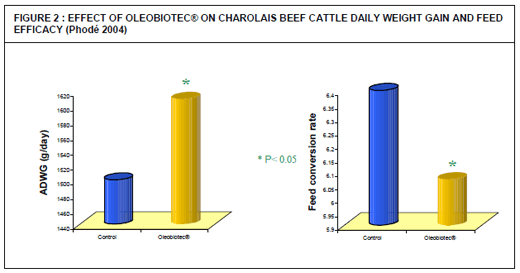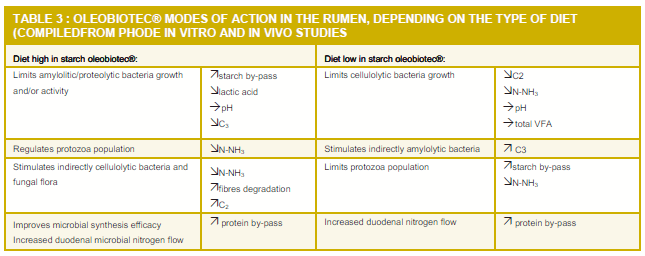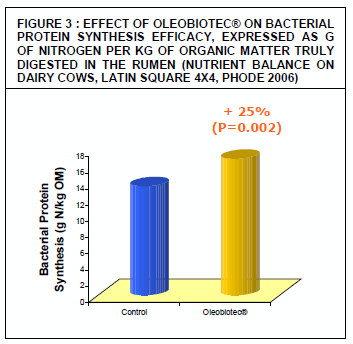Bio Regulation: A natural approach
Published: June 11, 2009
By: VIRGINIE NOIROT
TO OPTMISE RUMINANTS PERFORMANCE AND HEALTH, BIO REGULATON, A NEW CONCEPT, TARGETS EVERY STEP OF THE WHOLE NUTRTIONAL EXPERIENCE, FROM SENSORIAL STIMULATON AND APPETENCE TO DIGESTION EFFICACY AND DIGESTIVE HEALTH. VIRGINIE NOIROT EXPLAINS THE BENEFITS IN RUMINANTS.
Based on the idea that the health, nutrition and behaviour (stress, well-being etc.) of farm animals should be considered as a whole, Phodé R&D department has developed a very specific combination of natural plant extracts (essential oils, spices and natural flavourings) designed to act on the whole feeding process and enhance it at various levels (Figure 1).
Oleobiotec® works at different stages, both in the feed and the animal. First, the sensitive perception of the feed is influenced, which will improve the animal feeding behaviour (improves appetence and feed recognition), and well-being (specific natural flavourings). Secondly, the first step of the digestive process - the mouth - is triggered by spice extracts. The spices increase saliva production through the activation of heat receptors in the taste buds, acting directly on the digestive physiology. Ruminal digestion is influenced by a specific blend of essential oils, developed to improve starch, protein and fibre valorisation. Besides a better ruminal digestion, rumen health is also increased through the addition of spices.
The increased saliva production created by better digestion has a buffering effect, reducing sub-acidosis risks. Lastly, nutriment absorption along the gut is also optimised because the spice extracts increase gut mucosa permeability to nutriments.
IMPROVED PERFORMANCE IN BEEF CATTLE
To study the benefits of Oleobiotec® for beef cattle production, a trial was performed in a French research station (2004), involving 60 Charolais (average weight at start of trial: 334 kg), during 120 days. The animals were divided between two groups: control and treated, and were both fed a diet of 60% corn, 40% concentrate with straw and salts supplements ad libitum. In addition, the treated group received 1g/ animal/day of Oleobiotec®. Average consumption and daily weight gain (ADWG) were measured for each group. ADWG showed a significant increase with Oleobiotec® (+7%), while the average feed conversion rate was significantly lower (-5%), demonstrating a positive effect of the supplement on feed efficacy and animal growth (Figure 2). A second research trial, performed in Belgium (Belgian breed Blanc Bleu Belge), involving 2 groups of 35 animals (average weight at start: 465 kg), fed on grower feed and corn silage, showed the same trend: Oleobiotec® significantly improved ADWG by 4.8%. Most importantly, these trials were validated in farm conditions: production trials were performed with different breeds (Blonde d’Aquitaine, Limousine or Charolais), on different types of diets, involving over 150 animals in total. These trials showed that the same quantity of Oleobiotec® supplement used in experimental conditions results in improved feed efficacy, increasing the ADWG by at least 5% for the farmer. These trials are summarised in Table 1.

Click here to enlarge the image

Click here to enlarge the image
EFFECTS IN DAIRY COWS AND SMALL RUMINANTS
In dairy cows, several production trials show the impact of the bio-regulation complex on milk production, with increases of up to 1.5 kg/day/cow. In dairy ruminants, feed valorisation and milk quality are major concerns for farmers, together with health preservation of the lactating animals, necessary to insure longterm productivity. While this is true for dairy cows, it is even more predominant in dairy goats and sheep, where milk value is high and milk quality, such as somatic cells count, is an important factor of milk valuation. The effect of the bio-regulation complex on milk quality has been investigated in dairy sheep, goats and cows in several field trials. All show good results on somatic cells count, which is a sign of good sanitary conditions (Table 2). Moreover Oleobiotec® reduces area level in milk. A recent dairy cow trial, conducted in two groups of 10 Holstein breed (cross-over study), fed a diet containing 14.5% crude protein (CP) shows a 16% decrease in milk urea level (186 mg/L on average vs. 223 for the control group) for similar milk yields. This reflects an improved nitrogen utilisation in the rumen, which is linked to better ruminal protein synthesis. Another study corroborates this conclusion. In a French trial performed in 2005, milk yield increased with the addition of Oleobiotec® in the diet of Holstein dairy cows, while at the same time the addition of protein concentrate in the diet could be reduced by 22%.
A SET OF WELL-DEFINED MODES OF ACTION
The numerous trials presented illustrate the bio-regulation effects in ruminants, particularly improved feed conversation rate translated into better milk and meat yields, and improved health conditions (reduced somatic cell counts in milk). These effects, as mentioned before, are due to the combined actions of Oleobiotec®’s elements, first on the animals’ sensorial organs (increased appetence), in the mouth (increased saliva secretion), and then in the rumen and the gut of the animals. The modes of action of these elements in the digestive system of ruminants have been validated by five years of scientific research, first in vitro, then in vivo in canulated dairy cows, and can be summarised as follows:
- Improved protein utilisation: ruminal protein synthesis is increased due to the positive effect of the specific essential oils blend on rumen flora balance (Figure 3). This is measured by the decrease in ammoniac and urea outputs.
- Improved fibres digestibility, particularly with high starch diets, due to the relative increase of the cellulolytic rumen microbial population.
- Stabilised rumen pH, particularly with high energy diets. This is due to the combined actions of the specific essential oils on lactate producing bacteria in the rumen and the effect of the spices on increased saliva production (buffering activity) through the stimulation of heat receptors near the taste buds.
- Improved starch utilisation, with reduced carbohydrate loss (CO 2 and CH 4 emissions), due to improved ruminal flora balance.
- Reduced somatic cells count in milk and inflammatory reaction. It has been shown that eugenol (clove extract) and cinnamaldehyde (cinnamon), both present o, Oleobiotec® inhibit COX2 activity (cyclooxygenase-2 enzymes, which expression is triggered by inflammatory mediators such as bacterial toxins, correlated with mastitis prevalence).


Click here to enlarge the image

CONCLUSION
Bio-regulation, by optimising every level of the animal feeding experience, from feeding pleasure and behaviour to gut nutriment absorption, and not just digestion, represents a profitable, natural, and scientifically validated solution for the farmer. Moreover, the release of polluting agents in the environment, such as ammoniac or greenhouse gases (methane and carbon dioxide), is decreased due to better nutriment utilisation and reduced microbial degradation in the rumen, which is currently an argument that cannot be neglected. For the feed industry, this technology is very versatile and easy to implement; the additive is available in liquid or powder form, for different applications, and resistant to feed and premix production processes and storage.
Related topics
Authors:
Phode
Recommend
Comment
Share

29 de julio de 2009
We change it
Recommend
Reply
22 de junio de 2009
Hi:
I would like to know what happens with thr ruminan flora, you chage it or it,s adapted to the new diet?
Thelmo
Recommend
Reply

Would you like to discuss another topic? Create a new post to engage with experts in the community.







.jpg&w=3840&q=75)